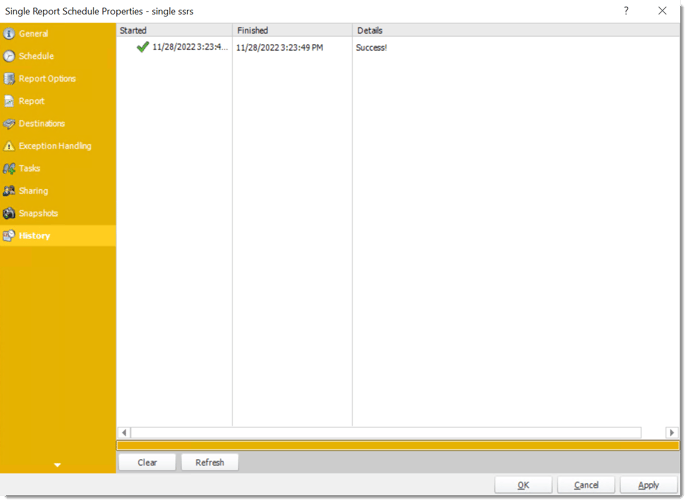How do I setup Single Report Schedule for Power BI Paginated on Premise or SSRS reports in PBRS?
The Single Schedule is the simplest and easiest way to schedule a Power BI Paginated report or SSRS report for delivery.
This article applies to:
- Power BI Paginated Reports (On Premise - Power BI Report Server)
- Microsoft SSRS Reports (On Premise - SQL Server Reporting Services)
Single Reports Schedule for Power BI Paginated Reports on Premise or SSRS Reports.
The Single Schedule is the simplest and easiest way to schedule a report for delivery. It involves defining the report you wish to schedule, determine its timing, selecting parameters (if any), and setting the destination (s) of the report.
Example: Jamie is a reports developer that must send a daily report to management detailing the number of support tickets currently open. She requires a report to be sent in PDF format at 8:30AM to three individuals.
How to Create a Single Schedule Report for Power BI Paginated Reports on Premise or SSRS Reports?
Step 1 - Navigate to Single.
Step 2 - Select For SSRS or Paginated Reports.

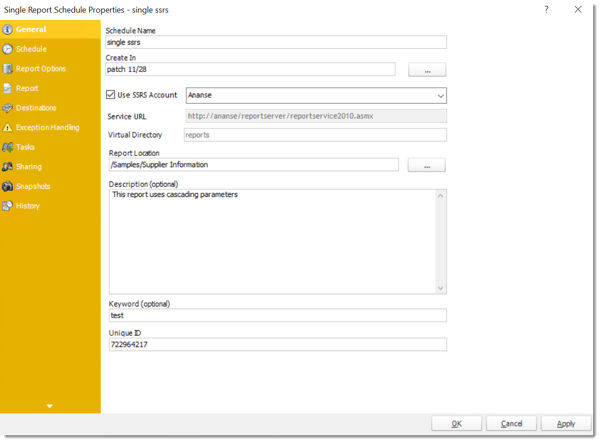
General Wizard
Step 3 - Complete the required fields in the General Tab of the Wizard.
- Create In: This section is for selecting the folder where you want to create the single report in.
- Use SSRS Account: Select the SSRS Account where your report server is located, and then click on (...) button next in Report Location.

Hint: SQL Azure Reporting Services- when writing your report, make sure you have enabled Forms Authentication. You should use the 2010 .asmx address for your reporting service URL.
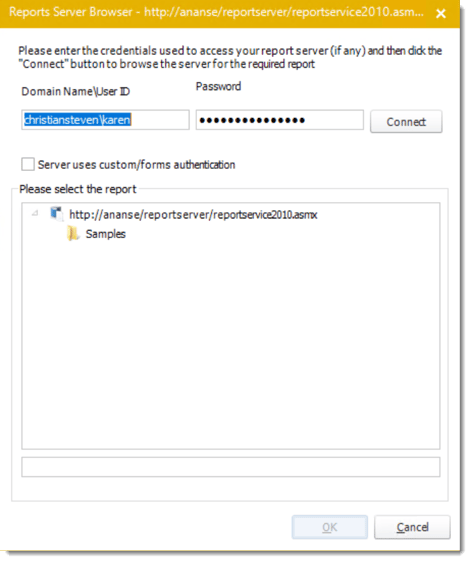
- Service URL: Uncheck 'Use SSRS Account' checkbox, to enter the address of your reporting services server.
- Report Location: Browse through the report server browser to select the desired report. Authenticate to the reports server if necessary.
- Schedule Name: Write in the name of the package.
- Description (optional): You may write a short description to help other users identify exactly what this schedule is and what it is expected to do.
- Keyword (optional): Enter some keywords which can be used later by Smart Folders to identify this schedule.
Step 4 - Click Next to continue to the next wizard section.
Schedule Wizard
Step 5 - In this section, you will decide when the report will execute. There are a variety of options.
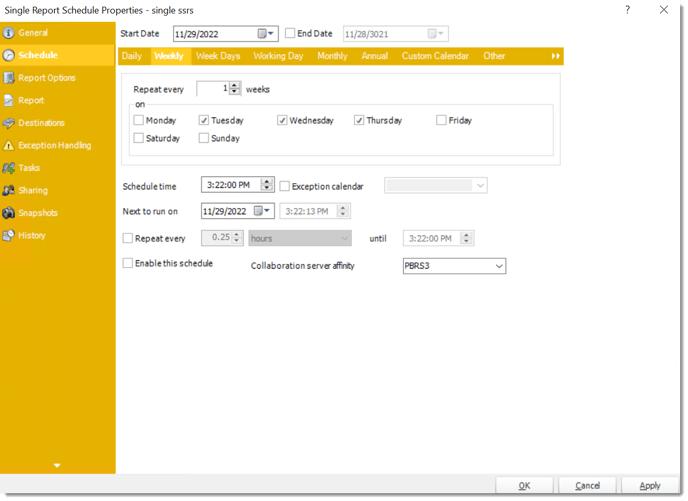
- Daily: Run a report every day or at a frequency of days.
- Sub options: Repeat every X Days.
Example: Run the schedule every 3 days.

- Weekly: Run a report on a weekly time frame.
- Sub options: Repeat every X weeks.
Example: Run the schedule every 2 Weeks.
- On: Select the specific days of the week the schedule will run. If only once a week, select only the day of the week it will run.
Example: Run every Monday, Wednesday, and Friday.

- Week Days: Run the schedule Monday through Friday.

- Working Day: Run the schedule starting on a specific day of the month. Indicate which day of the month the schedule will run. E.G. run the schedule on the 4th working day of the month.

- Monthly: Run the schedule on a monthly time frame.
- Use the following options: Checking this box will enable you to select frequency options such as the “last Thursday of the month.” Also you can include or exclude specific months from the schedule.

- Annual: Run the schedule every year at a specified time.

- Custom Calendar: Select the custom Calendar you wish to use. You can create a new custom calendar from the menu as well. Please see Custom Calendars for more information.

- Other: Other scheduling options.
- Run Schedule every X Minutes, hours, days, weeks, months, years.

- None: No scheduling is required for this item.

- Start Date: Enter the desired starting date for the schedule. This section can be the current date (providing schedule time has not already passed) or a date in the future.
- End Date: If the schedule is due to end after a certain date enter that here. If the schedule is to run indefinitely, then leave it blank.
- Schedule time: On the Next Run date, the package will run at this time.
- Exception Calendar: Choose a calendar that will instruct the schedule to NOT run on those specified days. Please see Custom Calendars for more information.
- Next to run on: The package will next run on this date.
- Repeat Every: Rerun the package every x minutes from the scheduled time until your specified time.
For example, you can set up a daily package to run every day at 8 am, and to run every hour until 5 pm.
- Until: After this date, there will be no automated scheduling of this package.
- Enable this Schedule: Uncheck this option to Disable the package. Disabled packages are not deleted, but they do not execute automatically. You can re-start the automatic scheduling at a later date by checking this option again. Or right-clicking this schedule from the main screen and selecting Enable.
Step 6 - Click Next to continue to the next wizard section.
Datasources Wizard
Step 7 - In this section you will authenticate to the database what the report runs against, set snapshots, and other options.
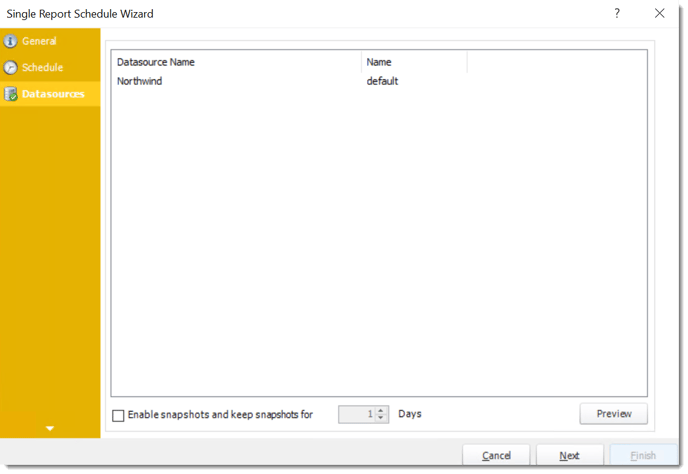
- Login Required: Set the authentication information for the report.
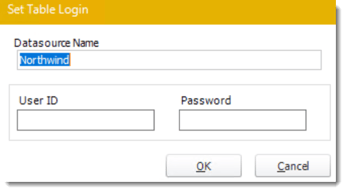
- Enable Snapshots and keep snapshot for X Days: Save a Picture of the report as it is produced. Choose the amount of time will be stored in the system before deletion.
- Preview: View the report prior to execution.
Step 8 - Click Next to continue to the next wizard section.
Report Wizard
Step 9 - In this section, you will determine the parameters for your report (if any). If your report has no parameters, you may skip this section by clicking next.
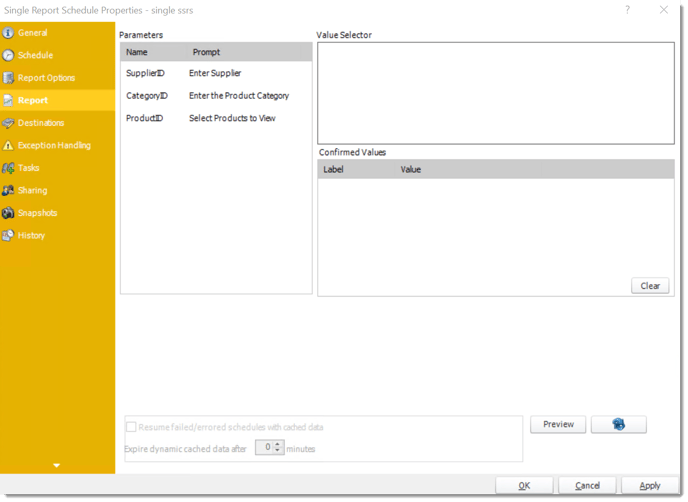
- There are 3 requirements in order for PBRS to detect your SSRS Report parameters and their parameter values:
- The parameter must be in use in the report.
- The parameter must be visible.
- The parameter must be set to be prompted at run time.
- If these three requirements are achieved, you should see the parameters in your report listed in this screen.
- For each parameter, select from the drop down list the value the report must use. In a single schedule, only one parameter value can be run at a time per parameter. You can type a value into the field, or drag and drop an "insert".

- PBRS can handle SSRS Reports with Cascading parameters, or reports where you can select multiple parameter values.
- Select All: Selecting All Available Values will run the report given all the values.
- Specified Value: Select the value you want in your report.
- Null Value: Set no value for this parameter.
- Default Value: It will select the default value.
- All Values (at run time): Any new values will automatically will be included at run time.
Tip: If you are looking to Dynamically populate parameter values, the better choice is Data-Driven Schedule.
Destination Wizard
Step 10 - In this section, you will decide where your schedule will be delivered. The list in the center will display the list of destinations you have added to the schedule. You can organize the various destinations’ order by clicking on the green up and down arrows.
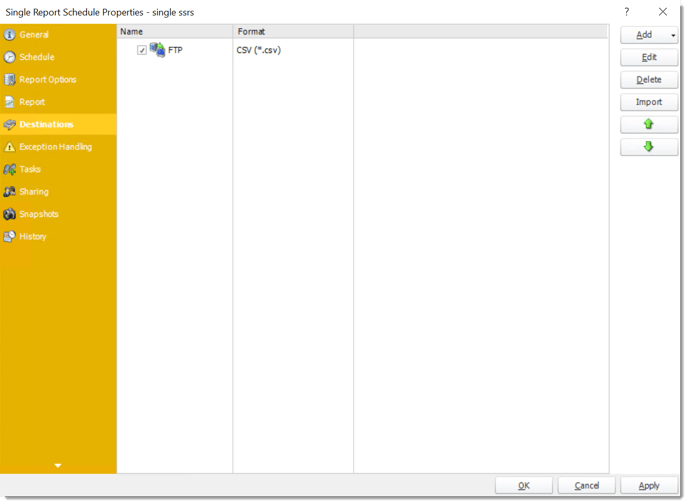
Step 11 - Click Add to configure a destination. You have several options which include: Email, Disk, Fax, FTP, ODBC, Printer, SharePoint, SMS, and Dropbox.
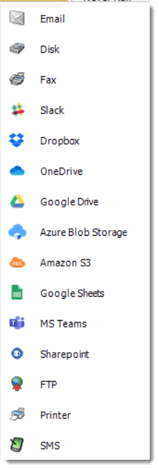
- Edit: Select a destination and click to edit it's properties. Or simply double-click on the destination.
- Delete: Select a destination and click this button to delete it.
- Import: Click here to import from the list of default destinations.
- For more information about Type of Destinations, click here.
- For more information about Output Formats, click here.
Step 12 - Click Next to continue to the next wizard section.
Exception Handling Wizard
Step 13 - In this section you will determine Schedule Retries should an error occur.

- Treat as “error” if not completed in X minutes: If a report takes longer than the specified amount of time to run, this option will treat the schedule as an error and follow the appropriate action. The “Auto-calculate” option instructs PBRS to automatically determine how long a schedule should take to run the report. If it takes longer than the calculated amount of time, then it is an error.
If manually determining the error timing, please double check the run time of the report in order to get the correct time estimate.
- On error, retry executing schedule every: If set to 0, PBRS will deem the schedule as "Failed" the first time it encounters an error. The schedule will not run again until its next scheduled time. Change the value to tell PBRS how many times you want it to retry running the report before declaring it as "Failed."
- Check if the Report is Blank: If a report is blank because it genuinely returned no data, recipients can misconstrue this as an error with the scheduler. This option allows you to identify genuine empty reports and instruct PBRS on what to do with them.
- Ignore the report and subsequent tasks: If the report is blank, do not send the report. The report will not be delivered to the destination. No custom tasks will be run.
Method
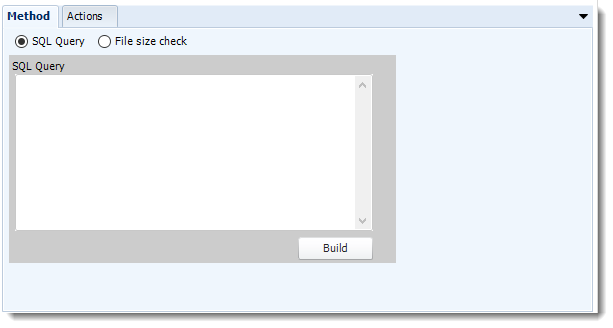
- Select the Method that will determine whether a report is blank.
- SQL Query: Select this option to use a user made query that will determine if the report is blank. If the query returns no results, the report is blank.
- Click Build.
- Get values from a database window will appear. For more information about Get values from database, click here.
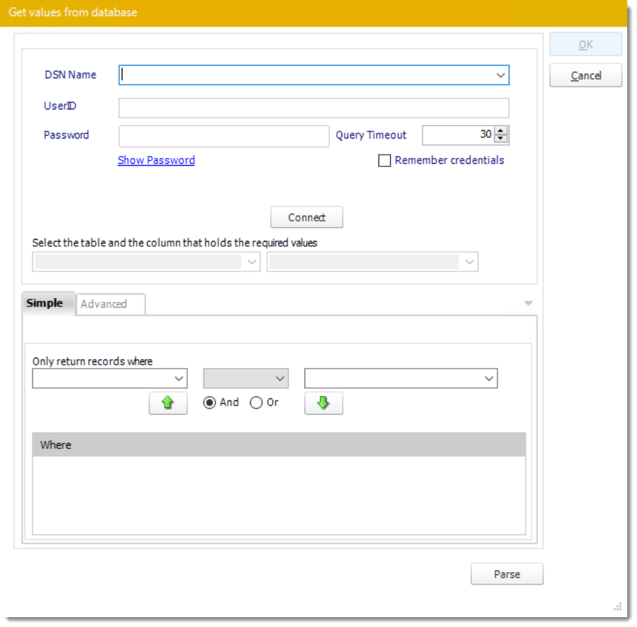
- File size check: Assume reports is blank if size is under "X" bytes.

Actions
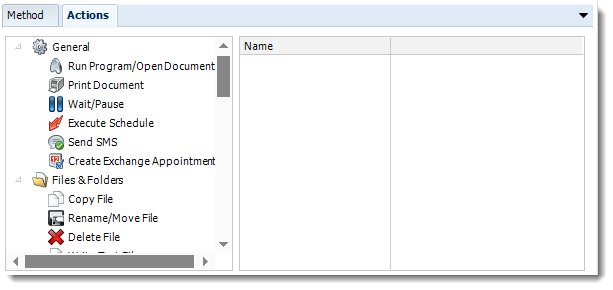
- Select an action from the task list. This task will be executed in the event that a schedule is blank.
- For more information about tasks, click here.
Tip: You can send a notification if a report is considered blank instead of sending the report. Simply select “check if a report is blank” then select “Ignore the report.” In the actions tab, select “Send Email” from the list. Compose your email and save.
Step 14 - Click Next to continue to the next wizard section.
Custom Tasks Wizard
Step 15 - In the section you have the option of setting up Custom Tasks. Custom tasks are business process automation tools that can be auto triggered before or after a report runs. Simply navigate to the task you would like to set up and drag & drop to the right hand side of the screen. This will automatically open the Configuration screen for the selected task.
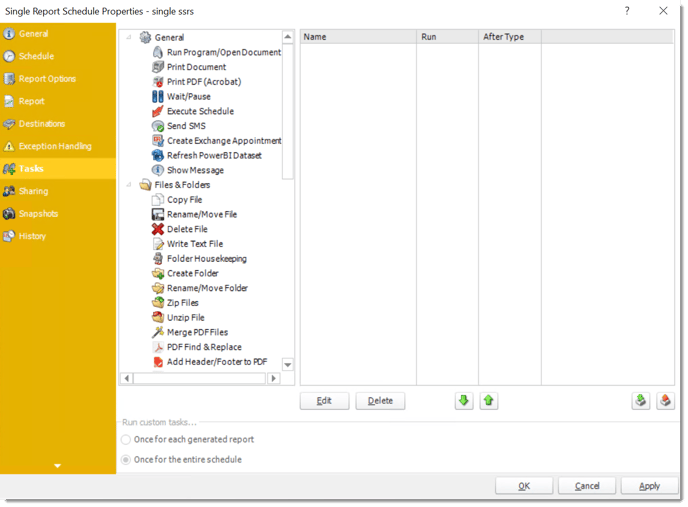
- For more information on Custom Tasks, click here.
Step 16 - If you have no desire to add a Custom Task, you can click finish to complete the schedule.
Single Report Schedule Context Menu
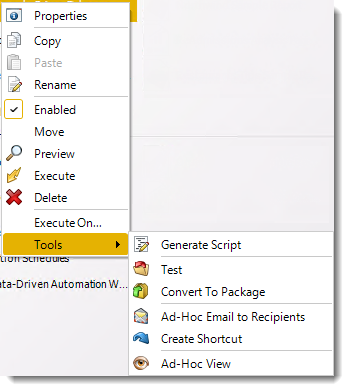
- Right-Click on a schedule to see the following actions:
- Properties: Edit the schedule from here. Or you can just double click on the schedule.
- Copy: Use this to copy the schedule. Right-click in the "white space" of the folder you wish to copy it to and select the Paste button.
- Rename: Rename the package.
- Enabled: Schedules are enabled when there is a check icon beside this option. To stop a schedule from running, or to "pause" it for a while, select this option to remove the check icon. Disabled schedules will not run until they are enabled again.
- Move: Use this option to move the report into an existing package.
- Preview: Preview the report before execution.
- Execute: This button will execute the schedule immediately. Note that the next run date and time is not moved on as a result of a manual execution. They only move on if the schedule is run automatically by one of the schedulers.
- Delete: Selecting this option will delete the schedule.
- Execute On: Use to option to execute the schedule to another collaboration server.
- Test: Use this option to test the schedule and export it to selected "test" destinations.
- Convert To Package: This button will move this report into a package. The package will have the name of the single schedule report.
- Ad-Hoc Email to Recipients: Select this option to send an ad-hoc email to all recipients of this package. You can use this to alert recipients to a planned system outage, or any other useful information.
- Create Shortcut: Use this option to create a shortcut you can save in any location on your PC. Execute the shortcut to execute the schedule in PBRS.
- Ad-Hoc View: This button allows you to preview the report.
Single Report Schedule Properties
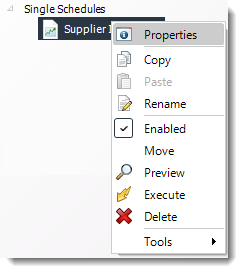
- To access your schedule properties, right click on a schedule and select properties.
- Similar to the schedule wizard, you can adjust settings to your schedule such as timing, error handling, or custom tasks.
- General
You can view the Schedule Unique ID in the General Wizard.
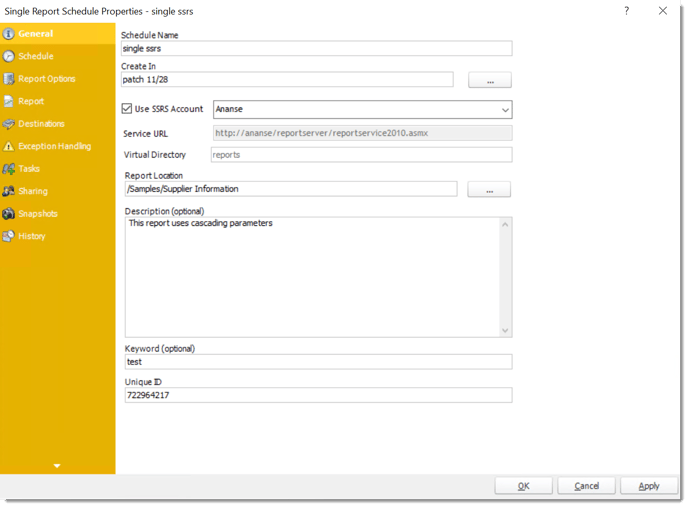
- Schedule

- Report Options
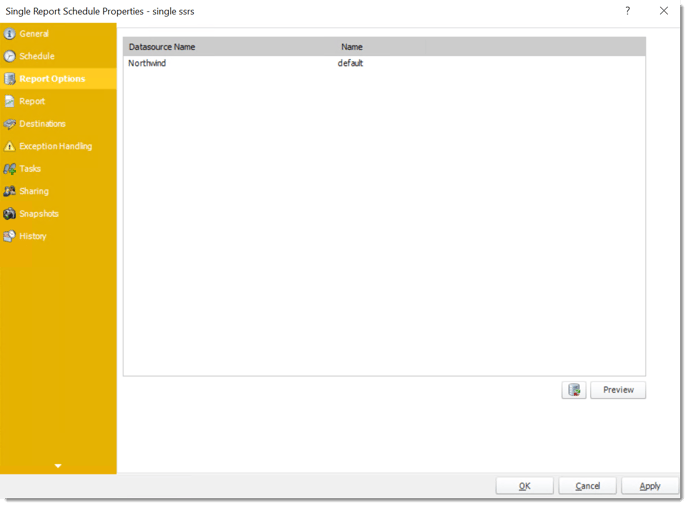
- Report

- Destinations

- Exception Handling

- Tasks

- Sharing: Here you can share this schedule with multiple users.
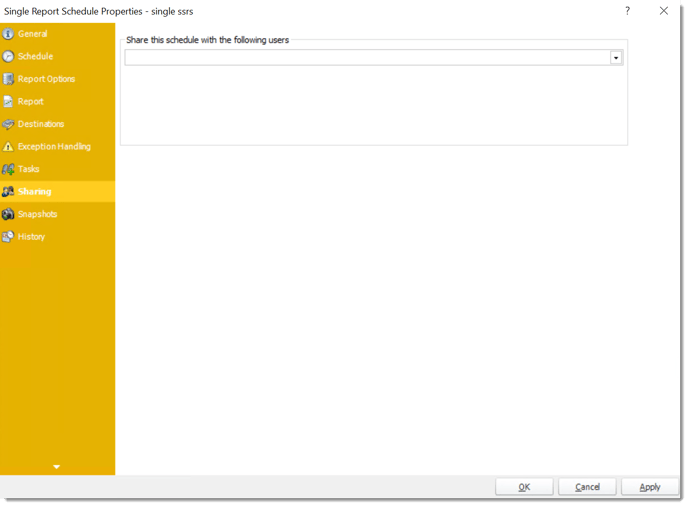
- Snapshots: A snapshot is a copy of each report a schedule or a package generates. Keeping snapshots enables you to resend past reports without generating them afresh - especially if the data has changed in the meantime.
- Simply select the number of days to keep the snapshots.
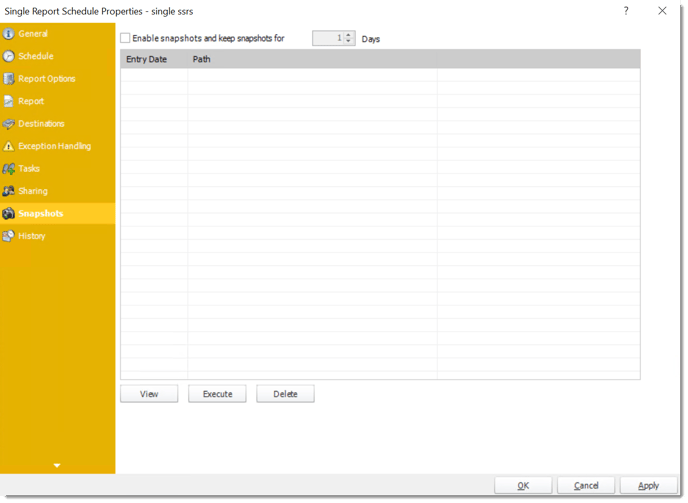
- History: Review the schedule's history. Successes, failures, and other data is located here.
